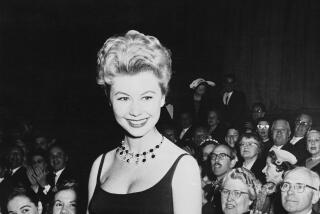Back in the Ring : Multiple sclerosis seemingly had Richard Pryor down for the count, but a return to his roots has revitalized the giant of stand-up
A Friday night capacity crowd has huddled into the Comedy Store’s main room. Accommodations are being made to squeeze in a few latecomers--Al Pacino, super-agent Guy McElwaine, film directors John Singleton and Peter Bogdanovich.
On the small stage, impressionist Roxanne Reese finishes a well-received set. Leaning into the microphone, she smiles widely: “Please welcome a man who is too legit to quit--Richard Pryor!”
Befitting the hyperbolic introduction, the veteran comic’s approach to the stage resembles the spectacle before a prizefight: a thunderous ovation, bodyguards, luminaries at ringside and--in the middle of all the action--an indisputable heavyweight who refuses to be counted out.
Richard Pryor, 51 years old and stricken with multiple sclerosis, is returning to his roots in stand-up comedy. His new act officially premieres Saturday night at the 3,700-seat Circle Star Theatre in San Carlos in the Bay Area.
“I wanna say something,” the thin, frail Pryor begins. “I’m not dead.”
Pryor’s no-frills take on Twain is a perfect icebreaker to an audience unsure of what to expect and unnerved by his physical appearance. Perhaps it’s just a reaction, seeing him today and remembering him in his prime. He looks so much more delicate, bony. The hair is shorter, and he has lost much weight.
Pryor relates the difficulties of his most recent acting experience, last year’s “Another You”: “I’m trying to go one way, and my body’s going the other. And the director thinks I’m trying to be funny!”
This is Pryor’s fourth recent appearance at the Sunset Strip nightspot, where he would often work out his routines in the ‘70s and where he has been trying out his new material since August. That was when he appeared on NBC’s 20th-anniversary salute to the club. He wasn’t on the bill but agreed to stand up.
“Richard came as my guest. He wasn’t planning to go on,” recalls Comedy Store owner Mitzi Shore. “He just felt he had to get up and perform. Doesn’t he look great?”
Compared to the Pryor of his hyperkinetic glory days, the comedian, who was diagnosed with the degenerative disease of the nervous system six years ago, looks far from great. His dark eyes seem pained; his movements are staccato.
Despite a slower pace, at Pryor’s best, his facial expressions still delight, his premises are clever, and his distinctive, expletive-laced phrasing hasn’t lost its edge. And he has something new to talk about; just as a notorious freebasing fire briefly ignited his comedy 12 years ago, talk of multiple sclerosis dominates Pryor’s routine tonight, including a joke about visiting Minnesota’s famed Mayo Clinic.
“You know this (stuff) is bad when you gotta go to the (expletive) North Pole to find out what’s wrong with you.”
“I know I’m one of your children,” he tells God, with whom Pryor has had his share of onstage confrontations over the years. “But what are you trying to prove?”
He proceeds to explain that his is not an extreme case of MS. God, he says, gave him just enough MS so that he can’t masturbate. “It’s funny when you’re looking at your dick and it goes, ‘Ha, ha, ha.’ ”
As always, Pryor’s act is peppered with four-letter words. But the illness adds a new vulnerability to his trademark sweetness. Midway through his set he looks out at the crowd and says, with disarming sincerity, “I appreciate being loved. Really.”
“This is the fourth night he’s performed here,” says Bogdanovich, an old friend. “Each time, he’s been on longer and he’s gotten better, and it’s been easier for him.”
After 20 minutes, Pryor brings back his old wino character Mudbone, first for a comment on the L.A. riots, then to close with a stock joke on the relationship between God and man.
Mudbone: Dear God, how much is a second?
God: A million years.
Mudbone: How much is a penny?
God: A million dollars.
Mudbone: Can I have a penny?
God: In a second.
Then Pryor is helped off the stage and shuffled into the back of a limousine in the parking lot.
“I don’t feel like I can breathe so good--but you’re gonna give me some oxygen, right, Marilyn?” Pryor asks rhetorically of his assistant, who smiles and nods. Health problems notwithstanding, Pryor lights a Marlboro and confirms that a nightcap waits for him at home.
The energy seems to drain from him as soon as he settles into his seat. He has never particularly liked interviews. But now his speech is more forced, almost a slur, his answers minimal.
“Stand-up is what I can do. I can’t do nothing else,” says Pryor, who says the impetus for his comeback, oddly enough, was a recent encounter with an ex-wife, Jennifer Lee. Her 1991 memoir “Tarnished Angel” included an indictment of their turbulent marriage.
“Jennifer inspired me, because she talked to me like I was a dead person. I said, f--- that. If I die, it’ll be in front of an audience.”
Pryor also took a stab at autobiography with the 1986 film “Jo Jo Dancer, Your Life Is Calling.” As a first narrative directorial outing, he couldn’t have picked a tougher subject. For the life of Richard Franklin Lennox Thomas Pryor is one of not just comedy but high drama, tragedy and epic sweep.
He was born Dec. 1, 1940, in Peoria, Ill., and performed in community theater productions as a boy. Ironically, it was not this stage experience but evocative remembrances of the denizens of his childhood that would eventually bring him fame. Raised by grandparents who operated a pool hall and a whorehouse, Pryor recalls his early years as a maelstrom of sex, booze, music and violence.
In 1962, after marriage and a brief stint in the Army, Pryor moved to New York, where for $5 a night he opened for singer Richie Havens. Pryor was especially encouraged by the breakout success of another black funnyman working the Village.
“I used to love Bill Cosby when I was a young comic,” Pryor says. “Watching him, I was in hog heaven.”
Pryor appeared in his first movie--1967’s “The Busy Body,” with Sid Caesar--and stayed busy as a hired gun in a string of undistinguished pictures. Then came “Lady Sings the Blues” in 1972, the overblown biographical movie that Pryor walked away with in a supporting role as Billie Holiday’s drug-addicted piano player.
He continued to carry Hollywood pabulum on his back with audience-pleasing, scene-stealing subversiveness, most notably teaching Gene Wilder how to “walk black” in 1976’s “Silver Streak.” But his true artistry became most evident when he shared a live stage with only a microphone.
“On ‘The Ed Sullivan Show,’ he would wear a jacket and tie and do one-liners,” says Phil Berger, author of “The Last Laugh,” a book on the comedy scene of the ‘60s and ‘70s. “It took Richard quite a while to evolve, to become the guy who imparted that sense of black life on the streets.”
That was when Pryor changed his language and became more profane and earthy. His 1979 film “Richard Pryor--Live in Concert” crossed over to non-black audiences and defined state-of-the-art, cutting-edge stand-up. You couldn’t wait to hear what he would say next.
Tonight at the Comedy Store, there is a certain pathos to the scene. You feel that Pryor’s best work is behind him. Pryor is still a naturally funny person, but he sometimes rambles during the show, as if he has lost track. He’s searching for a punch line that the audience can react to.
Still, they come to see him. Eddie Murphy, Arsenio Hall, Byron Allen, Dustin Hoffman, Barry Levinson, Warren Beatty and Annette Bening and “Saturday Night Live” regular Chris Rock have all made the pilgrimage in recent weeks.
“You should not even get on a stage and attempt to be funny,” Rock says, “unless you realize you’re never going to be as funny as Richard Pryor.”
Offstage, though, the laughs have been less plentiful, as Pryor has been a textbook victim of the trappings of success. He has endured several marriages and divorces, a tax-evasion bust and a Lenny Bruce-like disorderly conduct arrest. He took a gun and “killed” an ex-wife’s car. And, of course, Pryor took drugs, his favorite being cocaine, which--on June 9, 1980--literally exploded in his face.
Averting death but sustaining burns over 50% of his body, Pryor ducked the media’s third degree regarding what was generously called an accident. In 1982’s “Richard Pryor Live on the Sunset Strip,” he decided to come clean. “I mixed low-fat milk with pasteurized,” he confided to the audience. “Then I dipped my cookie in, and the (stuff) blew up.”
Pryor’s ultimate confession was in depicting the incident as a suicide attempt in “Jo Jo Dancer.” Twelve years later, it seems to have been a turning point in his career.
“After the accident, there was something sort of sad about him,” author Berger says. “The anger had been domesticated, and the magic was gone.”
In the decade since his sensational turn in “Sunset Strip,” Pryor has exploited his fame but not his talent. He functioned as a commodity in moneymaking duds like “The Toy.” Wasted in “Superman III,” Pryor nonetheless earned $4 million--$1 million more than franchise player Christopher Reeve. One bad film followed another: “Brewster’s Millions,” “Critical Condition,” “Moving” and two more outings with Gene Wilder--”See No Evil, Hear No Evil” and “Another You.” “I got greedy,” Pryor says. “I went for the bucks.”
“People don’t really know how to write for Richard,” says “Boyz N the Hood” director John Singleton, who was introduced to Pryor a few weeks ago and wants to put him in an upcoming film. “I don’t get easily awed, but I was when I met him. I grew admiring his work.”
In the late ‘80s, despite his knowledge of having MS, Pryor stayed relatively active. But the disease could not be overlooked anymore in 1989, when the gaunt, low-watt Pryor co-starred with longtime admirer Eddie Murphy in the flop “Harlem Nights.” Pryor now spends his days watching movies on video.
Something remarkable, however, seems to be happening to Pryor. Though admittedly an alcoholic, he appears more vital than he did on the Comedy Store TV special three months ago. And the main reason, friends agree, is the newfound interest in his work. “It’s keeping him alive,” Al Pacino declares.
All of Pryor’s fans have lived with his excesses. Books have been written about the severe manifestations of his rage. Now, though, he barely has the strength to stay on his feet.
“God loves me--I believe that,” Richard Pryor says just before the limo takes him home to an oxygen tank and a martini. “He may be pissed off sometimes, but he loves me.”
More to Read
The biggest entertainment stories
Get our big stories about Hollywood, film, television, music, arts, culture and more right in your inbox as soon as they publish.
You may occasionally receive promotional content from the Los Angeles Times.










